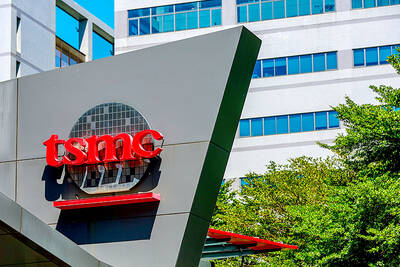Chip behemoth Nvidia Corp yesterday expanded its ties with India’s big firms, such as Reliance Industries Ltd, and launched a lightweight artificial intelligence (AI) model for the widely used Hindi language, as it looks to tap a growing market.
The company is hosting an AI summit in India’s business capital of Mumbai, where chief executive officer Jensen Huang (黃仁勳) chatted with Mukesh Ambani, the chairman of conglomerate Reliance and Asia’s richest man.
“Nvidia is AI in India,” Huang said.

Photo: REUTERS
“By the end of this year, we will have nearly 20 times more compute here in India than just a little over a year ago,” he added, referring to computing infrastructure.
From large companies to start-ups, businesses in India have focused on building AI models based on its diverse languages to expand their customer base and support activities such as AI customer-service assistants and content translation.
Nvidia said it was rolling out the new small language model, dubbed Nemotron-4-Mini-Hindi-4B, with 4 billion parameters, for firms to use in developing their own AI models.
“The model was pruned, distilled and trained with a combination of real-world Hindi data, synthetic Hindi data and an equal amount of English data,” it said in a statement.
Indian IT services firm Tech Mahindra Ltd is the first to use the Nvidia offering to develop a custom AI model called Indus 2.0, focused on Hindi and dozens of its dialects, the US company said.
Just one-10th of the population of 1.4 billion speaks English in India, where the constitution recognizes 22 languages, it added.
In addition to Tech Mahindra, Nvidia is partnering with India’s other IT giants Infosys Ltd, Tata Consultancy Services Ltd and Wipro Ltd, to train about half a million developers to design and deploy AI agents using its software.
Reliance and Ola Electric Mobility Pvt were among the companies that would use its “Omniverse” simulation technology, allowing them to test factory plans in a virtual world.
Unlike large language models, such as OpenAI’s GPT-4, used to power ChatGPT, small language models are trained on much smaller and more specific datasets. Typically cheaper as well, they are more attractive for companies with scarce resources.
Global chip firms are investing and setting up facilities in India as it races to build up its semiconductor industry and compete with major hubs such as Taiwan, although analysts say the effort could take years.
Since first setting up shop nearly two decades ago, Nvidia has established engineering and design centers in India, as well as offices in key cities such as the southern tech hub of Bengaluru and neighboring Hyderabad.
In September last year, Reliance and Nvidia vowed to develop AI supercomputers in India and build large language models trained on its languages. Later last year, Nvidia unveiled a similar partnership with Tata Group.

RUN IT BACK: A succesful first project working with hyperscalers to design chips encouraged MediaTek to start a second project, aiming to hit stride in 2028 MediaTek Inc (聯發科), the world’s biggest smartphone chip supplier, yesterday said it is engaging a second hyperscaler to help design artificial intelligence (AI) accelerators used in data centers following a similar project expected to generate revenue streams soon. The first AI accelerator project is to bring in US$1 billion revenue next year and several billion US dollars more in 2027, MediaTek chief executive officer Rick Tsai (蔡力行) told a virtual investor conference yesterday. The second AI accelerator project is expected to contribute to revenue beginning in 2028, Tsai said. MediaTek yesterday raised its revenue forecast for the global AI accelerator used

Taiwan Semiconductor Manufacturing Co (TSMC, 台積電) has secured three construction permits for its plan to build a state-of-the-art A14 wafer fab in Taichung, and is likely to start construction soon, the Central Taiwan Science Park Bureau said yesterday. Speaking with CNA, Wang Chun-chieh (王俊傑), deputy director general of the science park bureau, said the world’s largest contract chipmaker has received three construction permits — one to build a fab to roll out sophisticated chips, another to build a central utility plant to provide water and electricity for the facility and the other to build three office buildings. With the three permits, TSMC

TEMPORARY TRUCE: China has made concessions to ease rare earth trade controls, among others, while Washington holds fire on a 100% tariff on all Chinese goods China is effectively suspending implementation of additional export controls on rare earth metals and terminating investigations targeting US companies in the semiconductor supply chain, the White House announced. The White House on Saturday issued a fact sheet outlining some details of the trade pact agreed to earlier in the week by US President Donald Trump and Chinese President Xi Jinping (習近平) that aimed to ease tensions between the world’s two largest economies. Under the deal, China is to issue general licenses valid for exports of rare earths, gallium, germanium, antimony and graphite “for the benefit of US end users and their suppliers

Dutch chipmaker Nexperia BV’s China unit yesterday said that it had established sufficient inventories of finished goods and works-in-progress, and that its supply chain remained secure and stable after its parent halted wafer supplies. The Dutch company suspended supplies of wafers to its Chinese assembly plant a week ago, calling it “a direct consequence of the local management’s recent failure to comply with the agreed contractual payment terms,” Reuters reported on Friday last week. Its China unit called Nexperia’s suspension “unilateral” and “extremely irresponsible,” adding that the Dutch parent’s claim about contractual payment was “misleading and highly deceptive,” according to a statement